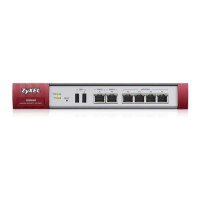173
5 In the General tab enable device HA and click Apply.
4.4.5 Deploy the Backup USG
Connect USG B’s LAN interface to the LAN network. Connect USG B’s WAN interface to the same
router that USG A’s WAN interface uses for Internet access. USG B copies A’s configuration (and
re-synchronizes with A every hour). If USG A fails or loses its LAN or WAN connection, USG B
functions as the master.
4.4.6 Check Your Device HA Setup
1 To make sure USG B copied USG A’s settings, you can log into USG B’s management IP address
(192.168.1.5) and check the configuration. You can use the Maintenance > File Manager >
Configuration File screen to save copies of the USGs’ configuration files that you can compare.
2 To test your device HA configuration, disconnect USG A’s LAN or WAN interface. Computers on LAN
should still be able to access the Internet. If they cannot, check your connections and device HA
configuration.
Congratulations! Now that you have configured device HA for LAN, you can use the same process for
any of the USG’s other local networks. For example, enable device HA monitoring on the DMZ
interfaces and use an Ethernet switch to connect both USGs’ DMZ interfaces to your publicly
available servers.
4.5 How to Configure DNS Inbound Load Balancing
This example shows you how to configure the USG to respond to DNS query messages with the least
loaded interface’s IP address. The DNS query senders will then transmit packets to that interface
instead of an interface that has a heavy load.
This example assumes that your company’s domain name is www.example.com. You want your
USG’s WAN1 (202.1.2.3) and WAN2 (202.5.6.7) to use DNS inbound load balancing to balance traffic
loading coming from the Internet.
1 In the CONFIGURATION > Network > Inbound LB screen, select Enable DNS Load
Balancing. Click Apply.
2 Click Add in the Configuration table. The following screen appears.
Select Enable, enter *.example.com as the Query Domain Name.
Enter 300 in the Time to Live field to have DNS query senders keep the resolved DNS entries on

